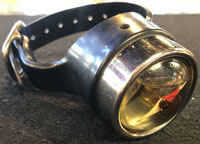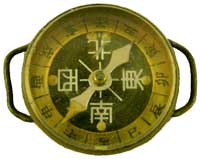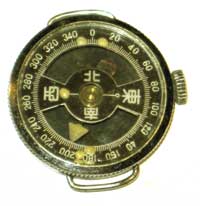Light
compass for hikers Description (German 1986 catalog) Click on images for enlarged views |
Wrist
compass for hikers, skiers and divers designed by PASTO
(model ABALONE) Description (German 1986 catalog) |
Techn.
Data
6570 ....... Techn. Data 6576 - Dia.: 50 mm / 2" - Fluid dampened needle |

 |
Diver
compass Technical Data - Diameter: mm - Manufactured: ? Picture courtesy www.thescubamuseum.com |
 |
 Photos by courtesy of Ebay seller sellingallmystuff2day |
 |
Technical
Data - Diameter: 40 mm - Depth: 10 mm - Manufactured: 3-53  |
 |
 |
 Plastic
casing
Plastic
casing Dia. : 45 mm. Marking on reverse: Сделано в СССР ФЭП (Made in USSR by FEP) Leather strap: 29 cm |
| Click on images for enlarged views |
 |
 Ad published in a specialized review |
Water
sport compass Technical Data - Diameter: 60mm - Thickness: 20mm - Weight: 70gr - Divisions: 360 degrees by 5, clockwise - Fluid dampened - Manufactured: 1960's (?) - According to the User Instruction (facsimile copy available), the markings were luminised. |
 Divers' compass Models SPORT 10 and 11 |
 Enlarged image: detail view of both models 10 (grey, leatherette band) and 11 (yellow or white) |
Technical
Data - Diameter: 55mm - Thickness: 20mm - Weight: 41gr - Divisions: 360 degrees by 5, clockwise - Manufactured: 1970's and 80's |
Description given in the official
service manual for divers of the FRG's army. |
 (Click on pictures for enlarged views) |
 |
Technical Data - Diameter: 51 mm - Depth: 13 mm - Weight: 37 gr - Manufactured: 1950's ? |
 John E. Hand & Sons was a U.S.
compass manufacturer
(more information HERE).
Besides ship compasses this company also built wrist compasses for Navy
and Airforce soldiers, especially the following wrist
compasses developed for the Navy in the 50's and 60's and
utilized by the UDT (Underwater Demolition Teams).
John E. Hand & Sons was a U.S.
compass manufacturer
(more information HERE).
Besides ship compasses this company also built wrist compasses for Navy
and Airforce soldiers, especially the following wrist
compasses developed for the Navy in the 50's and 60's and
utilized by the UDT (Underwater Demolition Teams).

 |
 Pictures courtesy dimaulo123 |
 Picture courtesy lockefordpawnshop |
 |
 In
this 1954 STOEGER's catalog several compasses were offered for
the huntsman.
In
this 1954 STOEGER's catalog several compasses were offered for
the huntsman. 
 (Click on images for enlarged views) |
 |
Technical data - Dia.: ? mm - Height: ? mm - Weight: ? g - Date on flyer: Aug. 1975 - Manufacturer:  |
 NO INFORMATION
MOMENTARILY AVAILABLE concerning the antique
and WWII items.
NO INFORMATION
MOMENTARILY AVAILABLE concerning the antique
and WWII items.
 |
 Click on the images for enlarged views |
Technical
Data - Diameter: 21mm - Depth: 6mm - Weight: 8gr - Divisions: No figures, only 4 cardinal points (in white paint) and 12 rhumbs (in black paint). For a detailed description of the 12 other signs, go to Religion/China. - No transit lock |
 |
 |
Japanese
wrist compass with rotating crystal (bezel) Technical Data - Diameter: 30mm - Depth: 9mm - Weight: 10gr - Divisions: 360 degrees by 2, clockwise - Needle transit locking: by turning the crown - Engraving on back: "Hold the compass horizontally for correct reading" |
 Existed also with English cardinals. We have such an item with a name engraved by hand on back (link to pic.) : Cabillis Guillaume (Click on images for enlarged views) |
 |
Technical
Data - Strap: leather, narrow at center (17mm), broad at both ends (22mm) - Capsule: Aluminum in brass case - Dia.: 33m, thickness: 10mm - Gradation: 360° clockwise on three black scales (figures and divisions), radium-paint markings (US version only), Cardinals: Japanese |

Tokyo Compass Mfg. and
MITSUI / DOXA catalogue pages for
wrist
compasses See also ATCO |
Model
name: Pathfinder |
 Click on the images for enlarged views |
Probably
made in the
50's or 60's. The black and white dial looks like the famous SINGER's
pattern
but the dividing line is on a NE-SW axis tilted by
45° and the southern half is dark! Technical Data - Diameter: 38mm - Divisions: 360° every 5, clockwise - Transit lock: side lever - Luminous markings |
| NESCO-marked
identical to Yokoyama below, centre Fancy wrist strap  |
Rotating
compass
card (No name)
|
NO MFR. NAME  |
Conventional
luminous
markings (no mfr. name - retailer in the U.S.: SEARS) |
| DOXA
(catalogue no. 336) with lid Descr. see top row, stamped ABOLISHED Click on the image for a detailed view  |
Compare to YOKOYAMA's
catalogue 
 |
DOXA
(no. 218) Instrument sold for 50˘
with the NABISCO Shreddies |

 Ladislav KADLEC was a Czech
engineer. He created in the 1920s a company that produced compasses for
the
Czechoslovak Army
before World War II, the German Air
Force Luftwaffe
during WWII and the Czechoslovak People's Army (ČSLA)
after WWII. The company existed for a short time after WWII but
was
taken over by MIKROTECHNA in 1948 by decision of the communist
government.
Ladislav KADLEC was a Czech
engineer. He created in the 1920s a company that produced compasses for
the
Czechoslovak Army
before World War II, the German Air
Force Luftwaffe
during WWII and the Czechoslovak People's Army (ČSLA)
after WWII. The company existed for a short time after WWII but
was
taken over by MIKROTECHNA in 1948 by decision of the communist
government. 1 - Model
AK 39 / L 10 & LK 10
1 - Model
AK 39 / L 10 & LK 10  The company's name KADLEC Instrumentenfabrik Prag
(German translation of Továrna
Přístrojů Praha,s. below, center) is not indicated on all
items.
Click on images for enlarged views |
NOTE: Early items were marked LK 10 (link to pic.) instead of AK 39. Others feature the confidential manufacturer's code used in Germany during WWII: jlr Pictures courtesy Z. Brotesser |
Technical
Data - Diameter: 62 mm - Height: 20 mm - Weight: 80 gr Markings on obverse face: - Armbandkompass (wrist-top compass) - Bauart (manufacturer): Kadlec - Baumuster (item type): AK 39 (or LK 10) - Werk-Nr. (Serial no.): xxxxx - Anforderungszeichen (Procurement no.): Fl 23235 |
 Taking a bearing with the rifle-type sights:  Some items had RED (link) sighting aids, commissioned already in 1943 (link to picture: markings on box) |
  Pic. at r. ctsy. O. Dobrkovský
View from below with the two white adjustable marching course half-discs. At right: the same model made after WWII for a short time together with LK logo and designated LK 30 Technical Data - Dim.: same as above - Ref.: Fl 23235-1 |
 (Picture courtesy Peter Miles) Special inscription on the items without the manufacturer's name: V-Muster = Verbrauchsmuster ('non maintainable') Additionally, a (production?) date was indicated: e.g.: 7. VI. 1943 (June 7, 1943) Manufacturers: License production by C. Stockert & Sohn and PREMA (picture of letter by courtesy of Frank LIEBAU, see his Website Die Kompassmacher). |
| The
compass was carried at
the right wrist - if necessary together with an additional strap (pic
below) over the suit's sleeve - or attached to the rescue vest
(see pic. at r.). |
 Photograph published by the Reichsluftfahrtsministerium and probably used for training purposes. |
  |
Military Model vz. 53   (Click on the images for enlarged views) |
Civilian Model LK-34 |
 Taking a bearing with the rifle-type sight 
 Red scale at the underside with the industrial codes lhx and sbe. |
Model vz. 53 of the ČSLA -
Czechoslovak People's Army Technical Data - Diameter: 48mm - Height: 20mm - Weight (with strap): 30gr - On transparent disc inside: divisions in degrees or MILS and semi-circular scale 9h-3h - Divisions on bezel of the vz.53 model: 360 deg (white figures) and 6000 Mils (sovietic Warsaw-Pact system, red figures) plus cardinals in Czech language. Luminous markings every 15 deg. - Divisions on bezel of the LK -34 model: only degrees in white figures, no cardinals. - Divisions on card: Both versions featured a transparent disc with an additional semi-circular graduation : 9h - 3h. The vz.53's card divided in MILS features an abbreviation (dc - link to drawing in User Instr.) which we cannot explain for the moment. Maybe "declination"? Description in Czech language:  Picture courtesy T. Hrebik |
| Model vz.53 Official Army Manual  Picture courtesy sberatel.skybazar.cz |
PAL
flyer Version LK-34 Picture courtesy sbazar.cz |
The version LK-34 as a Survey Instrument |
Model LK
34 in documentation 1) Vzdělávání členů SH ČMS (Sdružení hasičů Čech, Moravy a Slezska) - práce s mládeží - Education of members of SH ČMS (Association of Firefighters of Bohemia, Moravia and Silesia) - work with youth and 2) STOPA – časopis pro děti a mládež - STEPP (footprint) - magazine for children and youth |


The compass
(Fig. 51) is used to work out direction under water. It can also be
used on the surface during the day or night.
The KNM
(KHM
in cyrillic letters) compass consists of the three main parts: body
(4), card (3) and base (7). The compass body is a truncated cone made
of transparent plastic. The bottom part of the cone is joined to the
base. A scale (8) is engraved on the side surface of the body. There is
10 deg. between marks and 30 deg. between digits. Two hands are
engraved on top of the body parallel to the lubber's line 0 –
180 deg.
Two trackers are installed there as well: subject tracker (9) and eye
tracker (2). In the middle of the base a column with a pin is fixed.
The compass card rests on it. The compass card is made of the same
plastic as the body. The card has two magnets placed parallel to each
other. A hand is engraved on top of the card. Marks, hands, trackers on
the compass body and hands on the card are covered with fluorescent
paint that make it possible to use the compass in darkness.
To minimise
card pressure, pin friction and stop it vibrating, the body of the
compass is filled with 50% glycol solution or 43% ethanol solution.
However, there is still a small air bubble left (diameter
8–10 mm). The bubble is necessary to stop pressure mounting
in the body when the liquid expands. It also shows the horizontal
position of the compass. When the compass is in horizontal position,
the bubble is inside the circle (1) that is drawn on the compass body.
The compass base is an aluminium ring that encircles the body. There is
an index (6) on the base and two bars (5) used to attach the strap. The
strap is used to secure the compass on a diver’s wrist. The
body of the compass can be easily turned in the base so that any
bearing
can be aligned with the index. Such alignment is useful so that a diver
does not have to remember a set direction under water.
To move under water or on land according to the set azimuth, its corresponding mark needs to be aligned with the index on the base. The compass needs to be in horizontal position and needs to be rotated in an horizontal plane until the card hands are parallel to the body hands. The direction of the movement is decided from the index on the base.